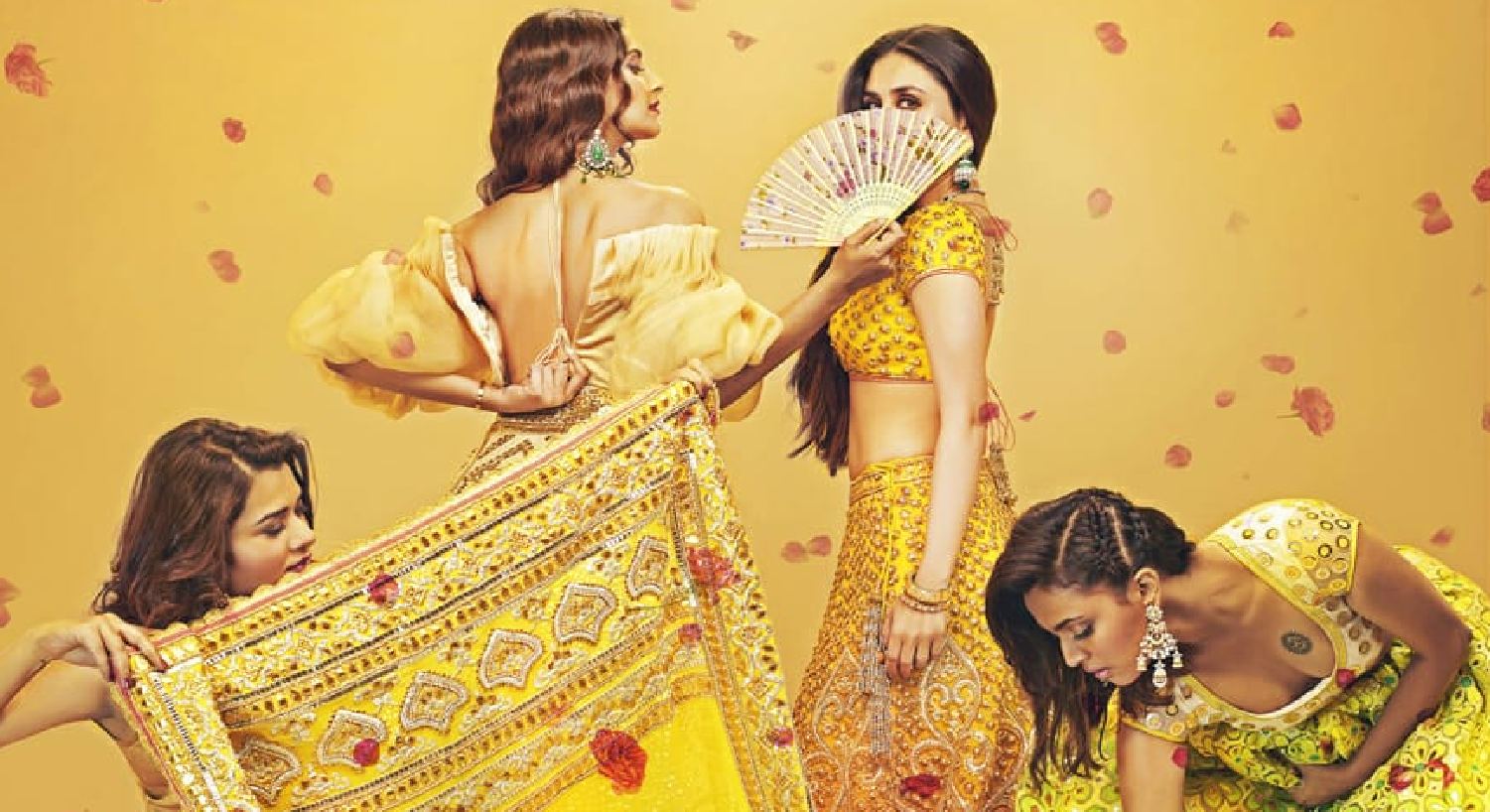From Lust Stories to Veere Di Wedding: Everything Bollywood Gets Right (And Very Wrong) About Female Pleasure
– Paroma Raha
I think we can all agree that the introduction of the word “charam sukh” in mainstream Bollywood via four women sitting in a car and casually having a conversation about sex and orgasms in Veere Di Wedding was definitely a cultural reset. Content on female sexual pleasure is pretty scarce in Bollywood, let alone content that displays casual and nonchalant conversations about the same. Usually if a sexual woman is portrayed in a movie, it completely dictates the personality and depth of the character in question as well- by limiting it.
As a young Indian girl, Bollywood completely dictated my world view in my most formative years. It told me what expectations I should have from the people around me, and how the world works. The problem, of course, is that Bollywood, like much of pop-culture, is very distanced from reality. I remember asking my mom at 10 years old, what song her and my dad sang when they got married- I genuinely believed each couple did a musical sequence to profess their love the way it happened in Bollywood! But I also learnt to admire sexually liberated characters like Pooh (played by Kareena Kapoor Khan) from a distance, and cheer when she donned sanskaari clothes and prayed. I vividly remember when the song Zara Zara Touch Me came out, I was obsessed with it, and very guilty and shy about being obsessed with it- because it was the closest a song came to talking openly about sexual desire. I used to listen to it secretively in my room, and tried to imitate the sensual expressions Katrina Kaif made.
Historically, sex in and off itself has been a taboo in Bollywood. Earliest depictions of any sort of sexual pleasure showed flowers in the place of actual kiss scenes or sensual hugs between costars in the rain. The transition from this to today’s depiction of female pleasure has been simultaneously slow and inconsistent.
Bollywood has created an archetype of a sexual woman over the years. It’s usually an extremely beautiful and bold woman who is presented solely to look desirable to the male gaze; she is an object of fantasy and unattainable to them- thus she exists as an epitome of every man’s sexual fantasies. This was personified through item songs like Sheila Ki Jawaani and Munni Badnaam Hui; a sexually empowered woman who is every man’s fantasy and out of his reach. However, these women existed as fantasies and were never lead roles in movies as an object of romantic interest for the male lead. In fact, the romantic interest needs to be diametrically distanced from having a powerful sexual appeal. The best example of this is in the movie Cocktail, where two girls are presented with personalities that are a binary of sanskaari or bold and sexy. Veronica (played by Deepika Padukone), who is a modern girl is modern, sexy and doesn’t mind making the first move is only a passing character to the male lead, who ultimately falls for Meera (played by Diana Penty): the reserved sanskaari girl. The movie impacted me in several ways too. While I loved Veronica’s character a lot more than any other: I saw her as a side-character, or even a villain. I struggled with balancing my desire to be her, and my fear of what society would perceive me as if I was her- something the movie capitalized on heavily.
This doesn’t mean the other girl has no sexual appeal, of course. She is also created as an archetype of male desires: but the key is that she doesn’t know how sexy she is. She probably loosens up and is comfortable being sexy after a few drinks- as happened with Meera and other popular characters such as Naina (played by Preity Zinta) in Kal Ho Na Ho. However, women who know how sexy they are, make the first move, have sexual agency- are never seen as main characters in Bollywood- not until recently of course. In Ludo, Ahana Malhotra, (played by Sanya Malhotra), is made terrified at the possibility of her sex taping being seen by her fiancé- as a sexually active woman can never be perceived as a viable romantic partner. However, Ludo turns the stereotype on its head, by creating a happy ending for Ahana.
Enter Sakshi Soni, played by Swara Bhaskar. Her sexual pleasure is seen as a natural part of her life: not something that is made a big or central part of her character. While she is still the same archetype of a bold, sexy, and modern woman: she has agency over her sexuality. She pleasures herself when she’s frustrated, she exists in a friend group that openly discuss their sex lives, despite not all belonging to the same character arch as she does- including married women, women who aren’t as bold or sexy- but still see their sexual pleasure as important.
But Bollywood has, in recent times, explored female pleasure beyond this archetype as well. After all, it isn’t just bold modern women who need pleasure in their lives: it’s all of them. Lust Stories in particular challenges this stereotype through the story of Meera (played by Kiara Advani), Rekha (Neha Dhupia), and Paras (Vicky Kaushal). The context of the characters of the story isn’t the same fast paced modern girl-boss world shown in movies like Veere Di Wedding. Here, the characters are simple school teachers from conservative family backgrounds. But this doesn’t have to mean they don’t enjoy sex- or have sexual needs. The story shows how Meera’s character turns to self-pleasure to make up for the lack of sexual pleasure in her marriage, and ultimately has a dialogue with her husband about how her needs are important as well.
Similarly, some movies like Badhai Ho and Lipstick Under My Burkha challenge this stereotype even further by showing older women expressing healthy sexual desires and needing sexual pleasure as well. In Lipstick Under My Burkha, Usha (played by Ratna Pathak Shah) is an older woman who has phone sex and thoroughly enjoys it. Similarly, Leela (played by Aahana Kumra) enjoys consensual sex and recording it with her partner. In Badhai Ho, the sexual needs of older couples are also shown in a non-comedic and straightforward manner.
I mean, of course, no one likes imagining old people- especially their parents- having sex. We’ve all had that moment of existential dread where we’ve realized we exist because our parents did it and just felt grossed out by our existence. But a lot of this has been societal conditioning about sexual desires and age, particularly for women. We see sexual desire as a natural need for men at all ages: but something women shouldn’t have, especially after getting older and having children.
These films have certainly faced backlash from Bollywood in the face of their supposed boldness. The particular scene with Swara Bhaskar masturbating created widespread controversy, and Lipstick Under My Burkha faced several legal challenges in lieu of censorship. However, it is important to portray female pleasure in a multi-dimensional lens- because it is multidimensional in nature! All sorts of women have sex and enjoy it: modern, conservative, bold, shy, old, young – and they all deserve for it to be normalized in society. Bollywood needs to tell more stories of female pleasure from the lens of women themselves: this can be done by inculcating more female writers, directors, and female driven stories- as this will focus on telling these stories authentically, by looking at what women want and desire. Sexual women are normal women: and they should be shown as such. They should be women who can have a cheesy love story, a simple life, or a life outside of their sexuality being the sole driver in their personality- because sex needs to be seen as a normal part of their lives- and not something that necessarily sets them apart.









